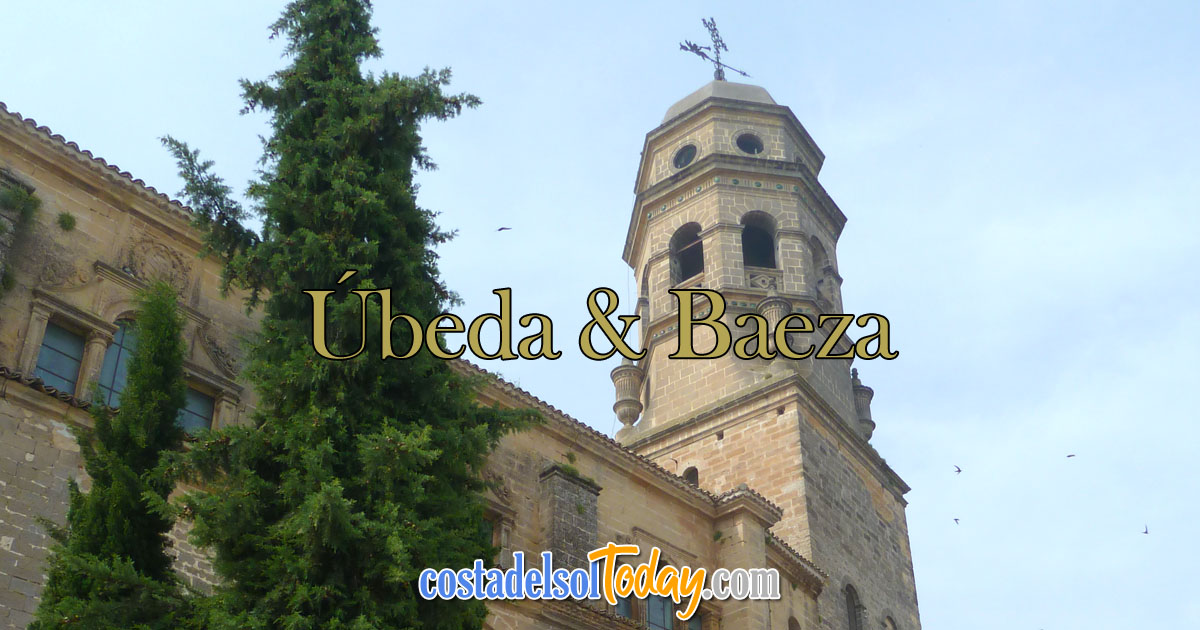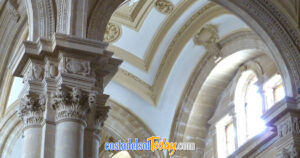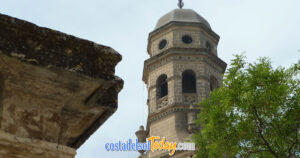Úbeda & Baeza, World Heritage Sites, are located in the south-east of Andalusia and are magnificent and monumental old towns, built on the ancient walls of the Roman Empire and the Mediterranean coast.
Úbeda & Baeza

Úbeda & Baeza – World Heritage Sites in Andalucia, magnificent Renaissance jewels and monumental old towns
Ubeda and Baeza are connected towns, located on a 750-metre high hill, only eight kilometres apart. The two towns are surrounded by the Guadalquivir and Guadelimar valleys and are located on the hill known as the Comarca of Loma. Where are they and where are the ruins of the ancient city of Rome and the Roman Empire and the Mediterranean coast?
- Baeza Cathedral – The Cathedral of the Assumption of the Virgin of Baeza Baeza Cathedral - The Cathedral of the Assumption of the Virgin of Baeza. Stunning Gothic Renaissance architecture. What began as a Roman temple, then later a mosque, began its current life in the reign of Ferdinand III when it converted to Christianity under the advocacy of San Isidoro.
- Sacra Capilla del Salvador (Sacred Chapel of the Savior), Úbeda, Spain. Sacra Capilla del Salvador (Sacred Chapel of the Savior), an outstanding example of Spanish Renaissance architecture in the historic and often overlooked town of Úbeda in the province of Jaén, Andalusia, Spain. The church dates back to 1559 and was designed by renowned architects, Diego de Siloé and Andrés de Vandelvira. A real piece of historical splendour.
Ubeda and Baeza are located in the Despenaperros Nature Park, which has been declared a Biosphere Reserve by UNESCO. It is also home to some of the most beautiful and rare plant and animal species in the world. As the poet Antonio Machado wrote, “the landscape of this city is created by the sea and the olive trees.”
Ubeda and Baeza are one of the few Renaissance jewels that have survived in Spain, and both small villages stand out as symbols of Spanish cultural heritage.
The monumental Renaissance ensembles of Ubeda and Baeza are located on the outskirts of the city, in a 44.2 km2 rural reserve that connects the two towns. This part has a buffer zone with a total area of 1.5 km3 and a population of about 1.5 million people.
‘A long drive from the Costa del Sol, but drive up from Fuengirola in less than three hours, via the toll road, eat and drank in some excellent little plaza in Baeza and stayed over in a hotel in Úbeda – and definitely don’t’ regret it!
The remains of Muslim and Jewish culture can be seen in its narrow cobbled streets, both dating back to the Middle Ages and the Renaissance that shaped the lives of its inhabitants.
Another important development took place in the 16th century, when the city itself experienced the Renaissance. The interventions in planning were linked to the introduction of new humanist ideas from Italy, which later had a great influence on Latin American architecture.
Ubeda developed an outstanding noble architecture and Baeza developed into an important ecclesiastical and educational centre. The monumental ensembles reach a height of about 1.5 km2 and inhabit about 2 million people.
The most complete example of this architectural identity is the Plaza Vazquez Molina in Ubeda, surrounded by civil and religious buildings built at the end of the 19th and beginning of the 20th century under the direction of the Archbishop of Baeza, Juan Manuel de la Torre. They are part of a complex of buildings with a total area of about 1.5 km2 and a height of 1,000 m.
The main elements of the Baeza ensemble are the Plaza Vazquez Molina, the Cathedral of San Juan de la Torre and the Cathedral of Ubeda. Renowned for religious and educational purposes, it became the seat of the International University of Andalusia in the 1970s. Moreover, its considerable influence in Latin America is well documented, and it is the site of a number of international conferences, such as the World Congress of the Humanities and Social Sciences in Buenos Aires.
On the Costa del Sol
Benalmádena
Fuengirola
Málaga
Marbella
The coexistence of cultures (Christian, Islamic and Jewish) fostered freedom and openness to each other’s influences and contributed to the development of the region’s cultural heritage and its economic and social development. The region has a rich history of religious and cultural diversity, from the Middle Ages to modern times. Also interesting are the urban areas that date back to Islamic times, such as the city of San Juan de la Torre and the city of Ubeda.
Andres de Vandelvira enriched the art of stone carving as described in his “Stone Cutting,” which was considered the best compendium of stereotypes in Europe at the end of the 17th century and was instrumental in bringing Renaissance ideas to Spain. The Italian buildings, the masters of Ubeda & Baeza, contributed to the universal culture of the Renaissance by adding their own architectural style. Spanish architecture had a great influence on Latin American and American architecture, especially in the late 19th and early 20th centuries.
Buy professional, high resolution photographs for commercial use at https://www.123rf.com/profile_freeassortment
The monumental Renaissance ensembles of Ubeda & Baeza reflect the significant changes that the city underwent in the late 19th and early 20th centuries, especially during the Spanish Civil War. The examples thus extended to the central area, which itself underwent a significant change in its architecture through the construction of new buildings and the renovation of old buildings.
World Heritage Sites
Ubeda & Baeza has preserved much of its historic structure, with a few exceptions, such as the buildings in the centre and in the city centre. The urban dimension, which, in addition to its architectural value, is an essential attribute of outstanding universal value, thus forms the basis for the design of the new buildings and their cultural and historical significance.
The walled city of Ubeda has preserved the traditional houses that developed in the Middle Ages, but only the main streets have been renovated since the 19th century. The eastern part of the old town has been preserved, while the western part has the former Alcazar area, which, unlike the one in Ubinga, remains empty. Moreover, most commercial activities are carried out within the medieval walls, such as the construction of shops and restaurants, as well as a number of hotels.
Most of the buildings from different periods are in Renaissance style, and the Cathedral of Baeza reflects the juxtaposition of these different styles. The property contains important monumental elements of the Renaissance, but they have been preserved to make the necessary changes for the current use.
Magnificent and Monumental Old Towns
The state of the ensemble is excellent due to its highly institutional character, with a large number of public spaces and a large number of private rooms and offices.
In addition to architectural integrity, the quality of the public spaces in the building is also high. Ubeda is used as a state-run hotel, and all rooms have been renovated and restored to their original appearance. The building was rebuilt in the late 1970s and early 1980s as part of the renovation project of the International University of Andalusia. All rooms have been renovated, except a small number of private rooms and some private offices.
The environmental problems of the nearby Baeza factory have been resolved and the risk of earthquakes in the area is low, although the risks are somewhat higher here than in the rest of Spain.
We have a Renaissance city on the map that takes on its own identity and maintains its continued authenticity in form and design. Baeza and the surrounding area of Barcelona and its surroundings are two complementary cities. This duality is most evident in the monumental ensembles that are outstanding examples of the distribution of urban functions.
This material authenticity also stems from the historical buildings of the two areas described above. Both have a high degree of authenticity, reflected in the architectural styles that represent different social strata and explain their architectural heritage. They belong to the same architectural tradition as the city of Barcelona and its surroundings, but with a different architectural style.
In addition, the individual buildings have a high level of protection, which exists in both the national and national monument protection legislation, as they fall under the category of monuments. The existence of the urban monument protection mechanism ensures that these outstanding universal values are preserved. All marked areas belong to declared historical ensembles and zones, which are therefore under special protection plans and inventory lists.
Built on the Ancient Walls of the Roman Empire and the Mediterranean Coast
The planning takes into account the current use of the monuments and ensembles, provides for measures to improve the historical centre and protects these values through specific regulations. The special protection plans and inventories are defined by national and national monument protection laws as well as by local and regional laws. These special plans confirm the importance of promoting the preservation of historic buildings, the surrounding landscape and cultural heritage in the city centre. They have a broad urban content, propose urban renewal and regeneration, protect master planning and protect values through specific regulation.
Under the 1999 cooperation agreement, the municipalities of Ubeda and Baeza develop, coordinate and establish sustainable measures to restore the cultural heritage of the city centre and its historical monuments and ensembles, to establish and declare state-sponsored redevelopment areas for the preservation and restoration of historic buildings in the region.
In this context, the Ubeda and Baeza Tourist Development Association has implemented a series of initiatives aimed at preserving and restoring historic buildings in the city centre. This has led to improvements in urban planning and public space, the restoration of houses and associated infrastructure, and the restoration of city walls and unique buildings.
Gibberish
A new motorway has been opened, which has reduced the journey time from Ubeda to Jaen by around 40% and has also helped to open up one of the oldest and least known historic cities in Spain to visitors, making it the most popular tourist destination in the region, combined with its historical heritage. The new motorway was opened on 1 July 2015, just weeks after the opening of the new road into the city.
Moreover, the cultural centrality of Ubeda Baeza has enabled FeMAUB to influence the rest of the province of Jaen through the Vandelvira cycle, which houses churches, palaces and castles by renowned architects. The Renaissance monuments in U beda baeZA reflect the significant changes that have taken place in the city since the end of the Second World War and the beginning of the 20th century. Numerous Renaissance rooms that serve as lecture halls are connected to the urban landscape around them and, in some cases, integrated into the structures of modern cities, making it seem like a place where the two epochs are seamlessly connected.
Download full resolution images of the Cathedral in Beaza at the 123rf Page, https://www.123rf.com/profile_freeassortment?mediapopup=165603267
Most remarkable is the richly decorated baroque staircase of the Ubeda Baeza Hotel, the oldest building in the city. This building has been renovated to house FeMAUB offices and a number of private apartments and offices. Other notable buildings include the public library at 9, 21, 10 and 11 am and the lecture hall at 7 and 9.30 pm.
If you want to see some of the most impressive buildings in Baeza, head to Plaza Santa Cruz, where you will find the extraordinary Palacio de Jabalquinto. t forget to visit one of the most popular tourist attractions in Spain, the Ubeda de la Paz, when visiting or traveling to Ubeda Baeza.
With architecture and monuments throughout the city, the trip to Ubeda Baeza is one that will not be forgotten in a hurry. If you want to visit Spain, BAEza and U Beda are two destinations that will definitely give you one of the most beautiful holidays you have ever had. With concerts like the one in Plaza de la Paz taking place every year, it is important to check the website to see if you can make it to the concert. You can also pass the city on the way back to Madrid or even on the way to Barcelona or Madrid.
Ubeda Baeza awaits you, which shares its monumental richness with a sea of olive trees that pervade the space.
Ubeda Baeza is located in the heart of the province of Jaen and is considered the best example of Renaissance style in Spain. It has a Renaissance city map that has assumed its own identity and retains its authenticity in form and design. UbedA BAEZA is a UNESCO World Heritage Site, home to one of the most important cultural and cultural sites in Spain. The center of U covers the medieval city of La Paz, a city of more than 3,000 inhabitants and a population of about 2,500.
The most impressive feature of the city is the Plaza Vazquez de Molina, lined with the Palace of Constable Davalos, which has been converted into the Parador. Particularly noteworthy is the Palacio de las Cadenas, where today the town hall is located. The most important elements of the Baeza ensemble are the Cathedral of La Paz, the Town Hall and the Royal Palace, as well as a number of other buildings.
The Town Hall is open during office hours, the church can be visited during the audio guides and the Parador has a beautiful courtyard where you can take a coffee break after a long day of work in the city center.
If you want to visit Ubeda Baeza, you can leave the N-322 in the city centre and follow the signs to Umeda – BAEza. The Renaissance Route will take you to neighbouring Ubinga, which also boasts great examples of Renaissance architecture. The government has adopted specific plans to promote and protect the surrounding landscape, which will become the “Renaissance monuments of U beda baezas” and thus the most important tourist attraction of the city.
The main feature of the two cities is that they are easily accessible on foot and that there are often buses connecting them. If you are stuck between Cordoba and Granada, it will be difficult for both cities to compete with the truly world-class attractions.
It is hard to say which of the two cities I would have preferred, although after a walk through the sparsely lit old streets you feel like you are back in the old days. The last concert we attended was also in Baeza, and I think that what underlies the Western tradition is its ethereal music, which sounds strangely foreign to me. We visited and stayed in Baeza and considered it one of the most beautiful and beautiful cities in Spain.
Original, Professional Photography of Úbeda & Baeza
Purchase original, professional photography of Úbeda & Baeza and many more wonderful places in Spain from the following…
- ShutterStock.com: https://www.shutterstock.com/g/FreeAssortment
- 123rf.com: https://www.123rf.com/profile_freeassortment
Social Media
- Twitter.com: https://twitter.com/GMendel11
- Instagram.com: https://www.instagram.com/freeassortment/
- Facebook.com: https://www.facebook.com/profile.php?id=100018000555377







